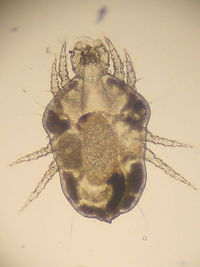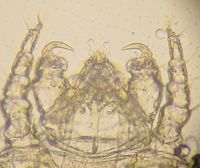Difference between revisions of "Cheyletiella spp."
(Redirected page to Cheyletiellosis) |
|||
| (12 intermediate revisions by 3 users not shown) | |||
| Line 1: | Line 1: | ||
| − | + | {{unfinished}} | |
| + | [[Image:cheyletiella.jpg|thumb|right|200px|''Cheyletiella mite'' - Kalumet 2004,Wikimedia Commons]] | ||
| + | [[Image:cheyletiella 2.jpg|thumb|right|200px|''Cheyletiella mite closeup'' - Kalumet 2006,Wikimedia Commons]] | ||
| + | Cheyletiella mites are [[Non-Burrowing Mites|surface mites]] of dogs and cats. | ||
| + | They are also found on humans and rabbits. They cause [[Cheyletiellosis|Cheyletiellosis]], a parasitic skin infestation. | ||
| − | [[Category:Non-Burrowing_Mites]][[Category:Cat | + | ==Identification== |
| + | |||
| + | They have a waisted body and claw like palps on their heads. They also have combs at the ends of their legs. | ||
| + | |||
| + | ==Lifecycle== | ||
| + | |||
| + | The lifecycle of a Cheyletiella mite lasts 21-35 days on the host. The adults mites can survive off the host for 2-14 days. They live on the skin surface and their eggs are attatched to hair shafts. | ||
| + | |||
| + | ==Pathogenesis== | ||
| + | |||
| + | The mites are highly contagious and cause mild pathogenesis. They are seen to cause very scaly dermatitis. Cheyletiella mites can be transferred to humans. | ||
| + | |||
| + | ==Diagnosis== | ||
| + | |||
| + | A diagnosis can be made on clinical signs, including the presence of excess scurf, or dandruff. | ||
| + | Scurf can be brushed onto dark paper, 'Walking dandruff' will be seen as mites will move when present in large numbers. | ||
| + | Skin scrapings and hair pluckings from scaly areas are also diagnostic. Eggs may also be present on the animal. | ||
| + | |||
| + | ==Important Species== | ||
| + | ''C.yasguri''- Most commonly found on dogs. | ||
| + | |||
| + | ''C.blakei''- Most commonly found on cats and humans. | ||
| + | |||
| + | ''C.parasitivorax''- Most commonly found on rabbits. | ||
| + | |||
| + | |||
| + | [[Category:Non-Burrowing_Mites]][[Category:Cat]][[Category:Dog]][[Category:Rabbit]] | ||
| + | |||
| + | [[Category:To_Do_-_AimeeHicks]][[Category:To_Do_-_Review]] | ||
Revision as of 14:32, 10 July 2010
| This article is still under construction. |
Cheyletiella mites are surface mites of dogs and cats. They are also found on humans and rabbits. They cause Cheyletiellosis, a parasitic skin infestation.
Identification
They have a waisted body and claw like palps on their heads. They also have combs at the ends of their legs.
Lifecycle
The lifecycle of a Cheyletiella mite lasts 21-35 days on the host. The adults mites can survive off the host for 2-14 days. They live on the skin surface and their eggs are attatched to hair shafts.
Pathogenesis
The mites are highly contagious and cause mild pathogenesis. They are seen to cause very scaly dermatitis. Cheyletiella mites can be transferred to humans.
Diagnosis
A diagnosis can be made on clinical signs, including the presence of excess scurf, or dandruff. Scurf can be brushed onto dark paper, 'Walking dandruff' will be seen as mites will move when present in large numbers. Skin scrapings and hair pluckings from scaly areas are also diagnostic. Eggs may also be present on the animal.
Important Species
C.yasguri- Most commonly found on dogs.
C.blakei- Most commonly found on cats and humans.
C.parasitivorax- Most commonly found on rabbits.

